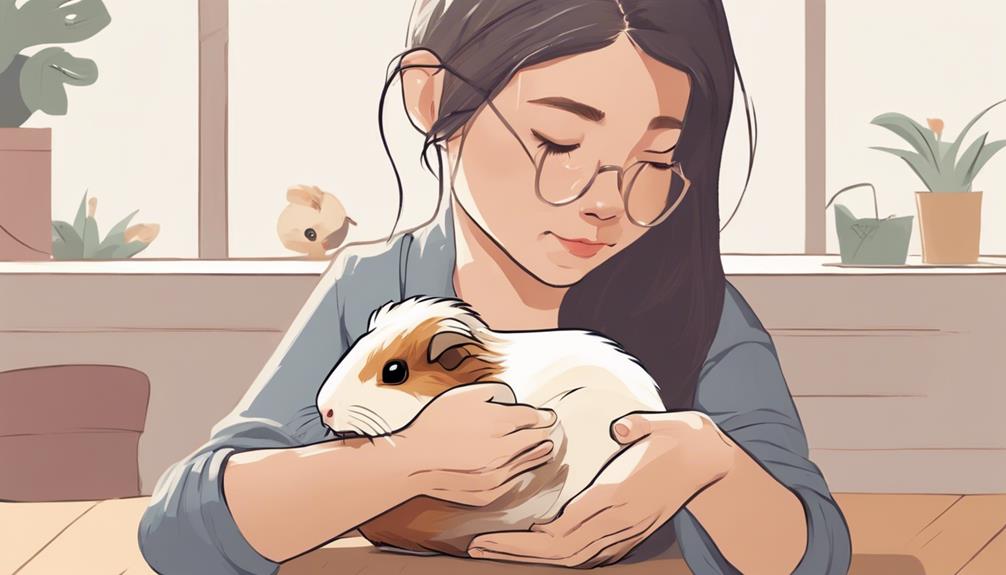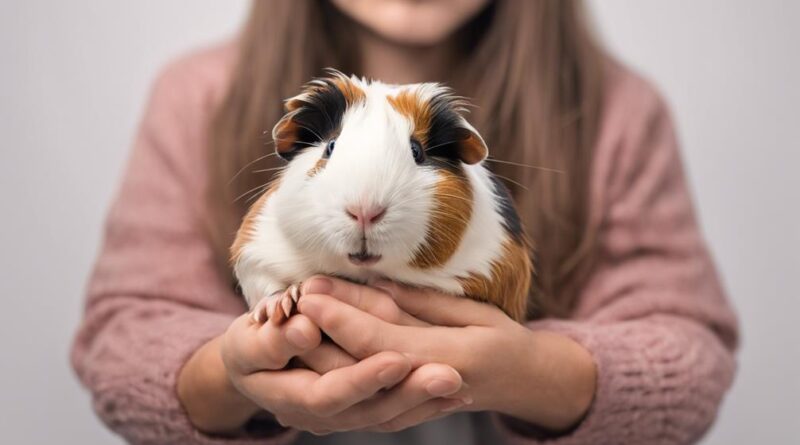Top Methods for Safely Handling Your Guinea Pig
Have you ever wondered if you're handling your guinea pig safely and correctly? Understanding the best methods for safely interacting with your furry friend is crucial for their well-being.
By following a few simple guidelines, you can ensure that your guinea pig feels comfortable and secure in your hands. Let's explore some key techniques that will help you establish a strong bond with your pet and create a safe environment for them to thrive.
Proper Technique for Picking Up
When picking up your guinea pig, gently slide one hand under its chest and use your other hand to support its hindquarters. Approach your guinea pig slowly and calmly, allowing it to become comfortable with your presence before attempting to lift it. This gentle handling is crucial to building trust with your pet and ensuring a positive interaction.
Maintaining proper posture is essential for both you and your guinea pig's comfort. Stand or sit comfortably, ensuring your back is straight to prevent any strain. Approach your guinea pig from the front to avoid startling it. With a firm grip under its chest and support for its hindquarters, lift your guinea pig gently and securely. This technique will help prevent any sudden movements that could startle or harm your pet.
Supporting the Hindquarters
To ensure proper handling of your guinea pig, always remember the importance of supporting its hindquarters when lifting or carrying it. Hindquarters support is crucial as it helps prevent unnecessary strain on your pet's delicate spine. When you provide this support, you show your guinea pig that you care for its well-being, which can help reduce handling stress and make it feel more secure in your arms.
Approach your guinea pig gently, speaking softly to reassure it as you prepare to lift. This gentle approach is key to building trust with your pet, helping it feel safe and comfortable during handling. As you reach to pick up your guinea pig, remember to place one hand under its chest for support and the other hand under its hindquarters. By lifting your guinea pig this way, you distribute its weight evenly, minimizing any discomfort or fear it may experience.
Supporting the hindquarters also allows your guinea pig to feel stable and secure in your grasp, reducing the likelihood of sudden movements or attempts to escape. This secure hold can help both you and your pet feel more at ease during handling sessions, strengthening the bond between you. Remember, a confident and comfortable guinea pig is a happy guinea pig.
Using Two Hands
For better control and balance, grasp your guinea pig with both hands, ensuring a secure and stable hold. Using two hands when handling your guinea pig is crucial for their safety and comfort. Start by gently scooping your guinea pig up, supporting their body with one hand under the chest and the other hand under the hindquarters. This method prevents them from feeling insecure or unsupported, fostering trust between you and your pet.
When you use two hands to hold your guinea pig, it shows them that you're there to protect and care for them. This gentle handling is essential for building a strong bond with your furry friend. It's during these moments that you can create positive experiences and quality bonding time. Consider incorporating cuddle sessions into your routine to further strengthen your relationship with your guinea pig.
Avoiding Sudden Movements
Maintain a steady grip and move your guinea pig smoothly to prevent sudden movements that may startle or distress them. When handling your furry friend, remember the following key points to ensure a safe and comfortable experience:
- Gentle interactions, building trust: Guinea pigs are sensitive creatures that respond well to gentle handling. By using soft and reassuring gestures, you can build trust with your pet, making them feel secure in your presence. Avoid sudden jerky movements or loud noises that could startle them.
- Slow movements, reducing stress: Slow and deliberate movements are essential when handling your guinea pig. Quick or erratic actions can cause stress and anxiety in these small animals. By moving at a calm and unhurried pace, you create a relaxed environment for your pet, allowing them to feel at ease in your hands.
- Observing body language: Pay attention to your guinea pig's body language while handling them. If they show signs of discomfort or fear, such as trying to wriggle out of your grasp or vocalizing distress sounds, gently place them back in their enclosure. Respecting your pet's cues and boundaries is crucial for their well-being.
Approaching Calmly and Slowly
When preparing to handle your guinea pig, approach calmly and slowly to establish a sense of trust and comfort for your furry companion. Building trust is essential for a positive interaction with your guinea pig. They're naturally skittish animals, so it's crucial to show them that you aren't a threat. Begin by sitting near their enclosure and spending time talking softly to them. This helps them get used to your presence and voice, building a sense of security.
Approaching your guinea pig slowly is key to establishing boundaries and ensuring they feel safe. Make sure your movements are gentle and deliberate. Avoid sudden gestures or loud noises that could startle them. Guinea pigs have a keen sense of hearing and can easily get scared by abrupt sounds. By moving slowly, you show your guinea pig that you respect their space and are considerate of their comfort levels.
As you approach your guinea pig, pay attention to their body language. They may show signs of agitation or fear, such as freezing in place or trying to hide. If you notice these signals, give them some space and try again later. Patience is crucial when building a bond with your guinea pig. Remember, by approaching calmly and slowly, you're laying the foundation for a trusting relationship with your adorable pet.
Ensuring a Secure Grip
To ensure a secure grip when handling your guinea pig, gently lift them using both hands supporting their body underneath. This method helps to prevent them from feeling insecure and reduces the risk of them wriggling out of your grasp. Here are some handling tips and safe grip techniques to keep in mind:
- Use Both Hands: When picking up your guinea pig, make sure to use both hands to support their body. Place one hand under their chest and the other hand under their hindquarters to provide full support and stability.
- Avoid Sudden Movements: Guinea pigs are sensitive animals, so it's essential to handle them gently and avoid any sudden movements that could startle them. Move slowly and smoothly to keep them calm and secure in your hands.
- Maintain a Firm but Gentle Grip: While supporting your guinea pig with both hands, ensure you have a firm grip to prevent them from slipping or jumping out of your hands. However, be gentle to avoid causing any discomfort or stress to your furry friend.
Communicating With Your Guinea Pig

When interacting with your guinea pig, pay attention to their body language and vocalizations to better understand their feelings and needs. Understanding body language is crucial in communicating with your furry friend. For instance, if your guinea pig is standing upright on their hind legs and making soft purring sounds, it usually indicates that they're content and comfortable. On the other hand, if they're crouching low to the ground with their teeth bared and emitting loud squeals, they may be feeling scared or threatened.
Vocal cues also play a significant role in deciphering your guinea pig's emotions. Guinea pigs have a wide range of vocalizations, each conveying a different message. For example, a high-pitched squeal often means they're in pain or distress, while low, rumbling noises can indicate happiness or pleasure. Paying attention to these vocal cues can help you respond appropriately to your guinea pig's needs.
Practicing Patience and Consistency
Understanding your guinea pig's behavior cues is essential when practicing patience and consistency in handling them. By being attentive to their signals, you can create a positive and trusting relationship with your furry companion. Here are some key points to keep in mind:
- Positive Reinforcement: Guinea pigs respond well to positive reinforcement, such as offering treats or verbal praise when they display desired behaviors. This method encourages them to repeat those actions and strengthens your bond.
- Training Techniques: Consistency is key when training your guinea pig. Whether you're teaching them to respond to their name or to use a designated potty area, using consistent cues and rewards will help them learn and feel secure.
- Building Trust, Bonding Exercises: Spending quality time with your guinea pig through bonding exercises like gentle petting, lap time, or interactive play sessions can help build trust. Consistent interactions will help your guinea pig feel safe and secure in your presence.
Frequently Asked Questions
Can Guinea Pigs Be Trained to Do Tricks or Follow Commands?
Yes, guinea pigs can be trained to do tricks or follow commands. Clicker training and positive reinforcement techniques work well with them. Start by associating a click sound with a treat to motivate your guinea pig.
Then, use positive reinforcement like treats or verbal praise when they perform the desired behavior. With patience and consistency, your guinea pig can learn fun tricks and commands.
How Often Should I Trim My Guinea Pig's Nails and How Can I Do It Safely?
When trimming your guinea pig's nails, do it every 3-4 weeks using specialized small animal nail clippers. Ensure good lighting and gently hold your pet to avoid stress.
If unsure, ask a vet or groomer for a demonstration. Use caution to avoid cutting the quick, the pink part of the nail with blood vessels.
Reward your guinea pig with treats and praise for a positive experience.
What Are Some Signs That My Guinea Pig Is in Distress or Feeling Unwell?
If your guinea pig is in distress or feeling unwell, watch for signs like behavior changes or lack of appetite. Weight loss or unusual dietary habits can also indicate a problem.
If you notice these symptoms, it's essential to contact an emergency vet for guidance. Remember, early detection and prompt action can help your little friend feel better sooner.
How Can I Best Introduce My Guinea Pig to Other Pets in the Household?
When introducing your guinea pig to other pets, remember to prioritize proper socialization. Start with gradual introductions under your watchful eye.
Supervise all interactions closely and provide positive reinforcement for good behavior. This approach helps create a safe and harmonious environment for your pets to coexist peacefully.
Are There Any Common Household Items or Foods That Are Toxic to Guinea Pigs and Should Be Avoided?
To keep your guinea pig safe, be aware of toxic foods and household dangers. Foods like chocolate, onions, and avocado are harmful to them. Certain houseplants and cleaning products can also be dangerous.
Always wash your hands before handling your guinea pig to prevent any harmful substances from transferring to them. Keep an eye out for potential hazards in your home to ensure a safe environment for your pet.
Conclusion
Remember, handling your guinea pig safely is crucial for their well-being and your bond with them. By following proper techniques, such as supporting their hindquarters and approaching calmly, you can ensure a positive experience for both you and your furry friend.
Remember to always communicate with your guinea pig and be patient and consistent in your interactions. With these tips in mind, you can enjoy a happy and healthy relationship with your beloved pet.
